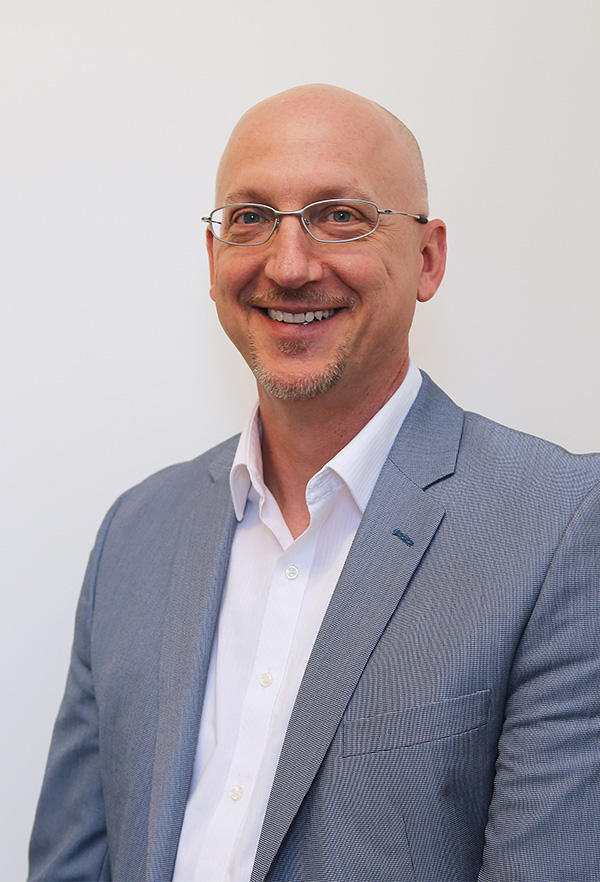
 John E. Taylor has joined the School of Civil and Environmental Engineering as the first Frederick L. Olmsted Professor. Taylor's work focuses on change, studying how it affects the civil engineering industry and how the industry adapts. He also studies reducing energy use in buildings and how disasters impac the mobility of city-dwellers. Taylor uses the lens of networks — human and engineered — to study these dynamics. (Photo: Jess Hunt-Ralston) |
John E. Taylor joined the School of Civil and Environmental Engineering in the summer of 2016 as the inaugural Frederick L. Olmsted Professor.
Taylor studies the dynamics where human and engineered networks meet, making him an ideal fit for an endowed professorship named for the father of landscape architecture and a designer who believed engineered infrastructure should be both functional and aesthetically appealing, serving society’s needs while also creating more livable and healthy communities.
“My own research, teaching and service have been at the intersection of human network and infrastructure network phenomena,” Taylor said. “Very recently I started integrating natural systems thinking at this intersection. I believe that Olmsted's life and work can really inform that integration and help me to deepen inquiry at this intersection.”
Created in 2014, the Olmsted Professorships are designed to give visionary engineering researchers the resources to work across traditional disciplinary lines. Taylor said that’s a unique opportunity that he couldn’t pass up.
“We hear a lot about the need for multidisciplinary thinking to solve the pressing challenges facing humanity, but there are relatively few faculty positions that explicitly task faculty to work across disciplines,” he said.
“I am extremely excited to be in a position that celebrates multidisciplinary research, teaching and service and honored and humbled to be in a position named for such an historic interdisciplinary figure.”
Taylor’s work is all about change.
He has studied how changes have buffeted the civil engineering industry, including how companies adopt and use inter-organizational information systems, how big engineering corporations expand globally, and how the industry can better connect their increasingly virtual workforces. More recently, his studies of change have turned to issues of broader societal importance: reducing energy use in buildings and understanding how disasters impact the mobility of city-dwellers.
“I’m excited about studying change. That doesn’t sound very exciting, but the work can never be dull if you’re always studying change,” Taylor said. “Once the change has widely disseminated, it’s no longer change, therefore we can move on to the next thing. It frees me up to pursue the next big thing that’s happening.”
|
Already, Taylor is crafting plans for his scientific and teaching endeavors as the Olmsted Professor, including using Atlanta as a springboard to broaden his focus to engineering change at the urban scale and as a test bed for his efforts.
“I want to take what we’ve learned about buildings and neighborhoods of buildings and push them to the urban scale to study sustainability issues, like energy consumption and conservation, and resilience issues, like disaster mobility and response,” Taylor said. “To do that, the opportunity here is to engage Atlanta as an urban living laboratory.”
Taylor already runs a virtual world that he uses to study globalization and how far-flung engineering teams can work together across long distances. He said he wants to build a virtual version of Atlanta in that system so he and his students can experiment on ways to remake the city.
“The idea is to concurrently and separately push real-world research, stuff that’s happening out there, and virtual-world research with the ultimate goal to pull them together,” he said.
One of the areas in which Taylor sees interesting opportunities is understanding what he called “the pulse of the city from an energy perspective — how people’s daily patterns affects energy use in the city.”
“We can know a whole lot about what’s happening in a building. We can know a whole lot about what’s happening in the city. But it’s very difficult to tie those together.”
Taylor worked as a project manager and co-founded several companies before starting his career in higher education. He comes to Tech from Virginia Tech, where he was a dean’s faculty fellow in the College of Engineering and a Preston and Catharine White fellow in the College of Architecture and Urban Studies.
“Georgia Tech, the College of Engineering, and the School of Civil and Environmental Engineering each have outstanding global reputations backed by world-class faculty, staff, students, and facilities,” Taylor said. “This reputation makes it an easy decision to want to come to Georgia Tech, but what may be less well known are the many exciting interdisciplinary efforts underway in the School and across the Institute.
“These, and the strong interest in collaboration across disciplinary lines, were also key considerations in my move to Georgia Tech.”
